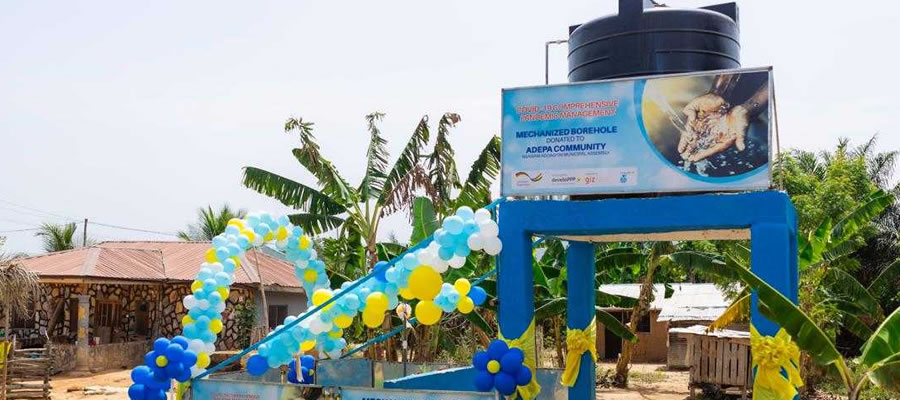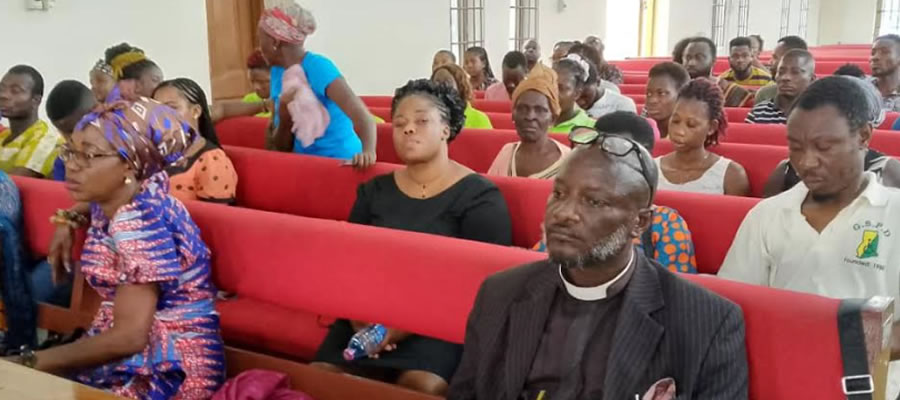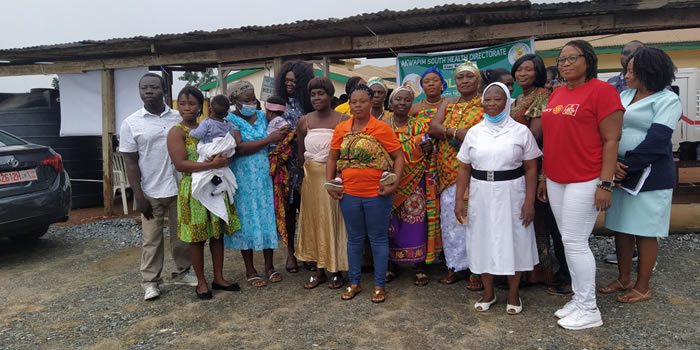

Population Size and Distribution
As shown in table 1.2, Akwapim South District recorded a projected population of 46,752 as at end of 2017. This Comprises of more females of 51.4% and males of 48.6% . The district is predominantly rural with 56 percent of the population living in rural areas as compared to 44 percent in the urban areas. The district has a total land size of 224.13sq.km and has a population density of 167.32sq.km. This means that the district is sparsely populated.
Population growth is estimated at 3.2% per annum which is higher than both the country’s rate of 2.7% and the region’s population growth rate of 1.4% per annum.
Sex ratio
From table 1.2, the sex ratio (the number of males per 100 females) of the district is 94. This means there are 94 males per every 100 females in the district. Urban sex ratio (85.5) is less than rural sex ratio (97.3). This implies more females than males are living in rural centers than in urban centres.
Age-Sex Structure
According to the projected population, 2017, the age structure of the district follows the regional and national patterns. It shows a youthful structure that is characteristic of a developing country like Ghana. As presented in table 1.3, the population less than 15 years age group recorded the highest percentage (37.6%) of the total population. The proportion of the male population of less than 15 years age group recorded 40.1 per cent whilst that of the female population is 35.2 percent. These proportions decrease consistently as the ages increase except for age groups 30-59 and 60 and over years which recorded higher populations than the 25-29 age groups.
As shown in Table 1.3, the sex structure of the district indicates that the number of males in the under 15 and 15-24 years age groups are higher than females. In the rest of the age groups, the number of females exceeds their male counterparts.
Population pyramid
The age-sex structure is graphically represented by a pyramid in Figure 1.2. The population pyramid shows a typical pattern in developing countries, with broad base denoting a youthful population, and a narrow apex, indicating fewer aged persons. The situation confirms the assertion that large cohorts are born at a particular year but the members exit through either migration, death or both. With increasing age (65 and above), the age-sex structure looks slightly thinner for the males than for the females, indicating that at older ages, the proportion of males is higher than that of females. The high proportion of the populations age 0-4 to 14-19 years indicates that the population in the district has the potential to grow for a considerable number of years.
Age dependency ratio
Dependency ratio is a measure of the dependent population made up of those below 15 years and 65 years and older on those in the working or productive group of 15-64 years. The ratio could be used to measure the economic burden borne by those in the working ages. In table 1.4, the age dependency ratio of the district is 76.7. This means that there are almost 77 persons in the dependent ages for every 100 persons in the working ages in the district.
Child dependency ratio (66.4%) is higher than old age dependency ratio (10.9%). Among the sexes, age dependency ratio for males is higher than females. Child dependency ratio is also higher for males than females. However, older age dependency ratio for females exceeds that of males.
Migration (Emigration and Immigration)
Migration indicates the movement of inhabitants from one place to another in a given period of time. Migration figures are always computed from one’s place of birth and place of enumeration data. According to 2010 Population and Housing Census, 59.7 percent of population were citizens of the district by birth as against 40.3 percent of the population who were born outside but resides in the district. This gives an indication that; in-migration to the district is high.
This wave of migration is similar to the region’s trends. The high in-migration has wide implication for planning the allocation of resources. While the district may benefit in terms of labour for economic activities, the additional population if not anticipated and factored into local plans, may cause pressure on existing socio-economic facilities.
Gender Equality
The 2010 population and housing census puts the population of male to female at 48.2% and 51.8% respectively. In terms of locality, more women (52.4%) reside in urban areas than men (47.6%) while more men (50.3%) are in the rural areas than women. An analysis of the societal roles played by men and women in the district indicates a mixed-role situation. While males dominate in the formal sector of the economy, females are mostly found in the informal sector. However, the Census puts female headed household in the district at 49.1% as against 49.9% male headed household.
The implication is that the burden of catering for members of most households rest on both female and male members. The traditional roles of males as heads of families and providers of daily sustenance have waned over time giving way to an atmosphere of partnership with their female counterparts. This has also resulted in the acknowledgement of the significant roles females play in the society and for that matter their inclusion in all decision making processes as indicated in the ensuing analysis.
Settlement Systems
The settlement system in the district can be described as either chained of communities or dispersed. Most of the urban communities are almost inseparable and hence can be described as chained-communities whereas the rural communities are scattered on their farmlands. The average household size in the district is 4.1 (GSS, 2010 PHC).
Location and Distribution of Services
The location and distribution of services within the municipality gives an indication of the level of development of the district. The scalogram, which depicts the presence or absence of a service, is used to determine which settlement lacks which services and facilities. This analysis also helps in project selection. The scalogram provides information on the population sizes of settlements and also depicts the centrality of each settlement within the district. Accessibility Maps have also been developed based on range and threshold requirements of each key socio-economic infrastructure.
Localities and communities
The District comprises of over Twenty (20) communities. The top seventeen (17) major settlements include the following:
Major Towns Areas
· Aburi
· Kitase
· Ahwerase
· Adomorobe
· Berekuso
· Pakro
· Konkonnuru
· Nsakye
· Attakrom
· Oboadaka
· Pokrom-Nsabaa
· Aburi-Amanfro
· Dumpong
· Obodan
· Dago
· Fahiakor
· Ahyiresu
Date Created : 11/23/2017 2:23:55 AM











 facebook
facebook
 twitter
twitter
 Youtube
Youtube
 +233 593 831 280
+233 593 831 280 0800 430 430
0800 430 430 GPS: GE-231-4383
GPS: GE-231-4383 info@ghanadistricts.com
info@ghanadistricts.com Box GP1044, Accra, Ghana
Box GP1044, Accra, Ghana